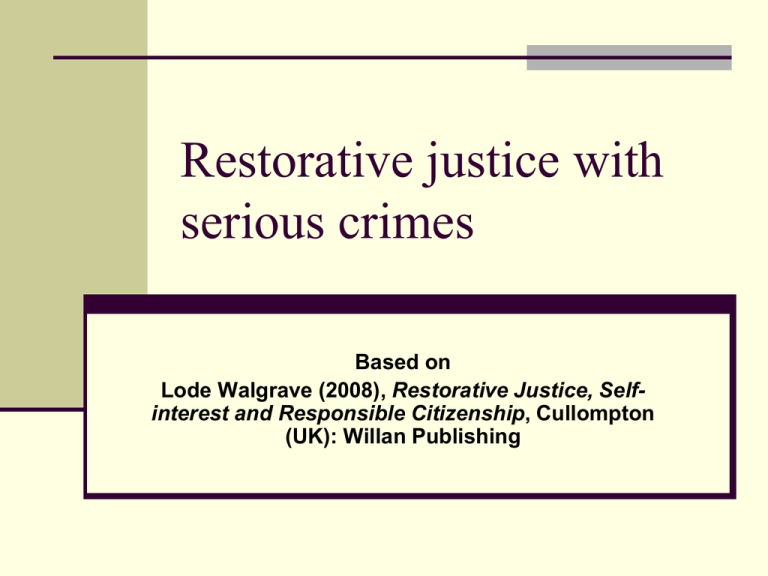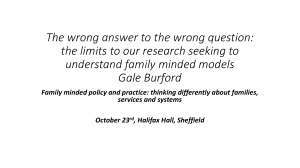Restorative justice with serious crimes
advertisement

Restorative justice with serious crimes Based on Lode Walgrave (2008), Restorative Justice, Selfinterest and Responsible Citizenship, Cullompton (UK): Willan Publishing Introduction RJ is implemented mostly for benign offences 1) serious crimes, more than other, must be responded by a punitive sanction 2) most rj processes only deal with the “private” dimension of the crime Experience and research do not exclude RJ for serious offenders Rj meetings can happen after serious crimes Victims are better off Better results regarding reoffending Why not for serious cases? (1) 1. Ineffective to influence offenders? 2. Retribution? - From vengeful emotions to retributivist theories But emotions are faded away and only public dimension of offence is dealt with Public dimension is important, which does not include the necessity for punishment - A moral obligation? Norm transgression must be censured (but not necessarily through infliction of pain) An intuitive moral balance must be restored (which can be done by seeing RJ as inversed constructive retributivism) Why not for serious cases?(2) 3. Victims’ need for punishment? Most research and experience show great willingness to participate in RJ programmes Victims want - public recognition that injustice has been done to them, - the opportunity to express fully their emotions about that - reasonable emotional, social and material reparation. 4. Some offenders are too dangerous RJ philosophy can be limited by concern for security Incapacitation or punishment? The difficulty with incapacitation Towards a kind of “actuarial” punishment? Provisional conclusion There is no principled reason to reject the applicability of RJ processes in cases of serious crime. On the contrary, the more serious the crime, the more need there is for thorough reparation Concern for security can overrule the priority for restorative responses RJ for serious juvenile crimes Two examples New Zealand (CYPFA 1989) Police- cautioning FGC (YJC) -Execution -Youth court Youth Court – FGC – Youth Court Youth Court cannot impose any measure or sanction without FGC being tried. All offences (except manslaughter and murder) including multirecidivists Results Arrests 1987 8000 1990 2000 2001 3000 Court (N/10.000) 400 200 240 Convictions 1318 269 234 Custody (adults court) 295 104 73 Family Group Conferences spread over the world as “restorative conferences”, “diversionary conferences” and other… Mostly as diversion, but not in NZ In NZ - Located in the heart of the procedure - Police presence in proper role of representative of public order - Lawyers are present Hergo in Flanders (Belgium) FGC according to NZ model Intensive research follow up January 2002- October 2003. Less intensive follow up till December 2005. Research methods (dossier analysis, questionnaires with facilitators, observation of conferences, structured interviews with participants, open interviews with professionals) FGC in Belgian procedure? Referred by court Provisional Order that “potentials of FGC must be tried out” Outcome is “Declaration of intention” Submitted to court, confirmed by formal judgement Execution begins after judgement New judgement to close dossier Well accepted and used. Endorsed by court of appeal Feasible in Belgian context? Till october 2003 (+ period 2004/2005) - 98 referrals by 9 judges (+ 53 referrals) - 53 conferences for 58 juveniles (+ 39 for 51 juveniles) - Average 16 yrs old, all male, serious offences - Victims in 26 meetings, represented in 10 other (+ 32 and 2 representations) - All end in DI, all confirmed by judgement - Professionals express their contentment Since then: - More FGC’s, confirmation of potentials - inserted in New Law Rights respected? Judicial confirmation Juvenile’s lawyers in all but 3 conferences. They find that they can play their role Victims’ lawyers attended seldomly. Victims did not feel this as a disadvantage Participants felt that their rights were respected (one exception) Participants feel high rates of “procedural justice” (Tyler) Positive answers on Procedural justice questions (%) Vict. Off. N=39 N=48 Did you find the FGC honest? Did you understand what happened? Could you say what you had to say? Have you been treated with respect? 77 95 95 100 83 90 69 91 Satisfaction? Vast majority expresses satisfaction with information received, with support during the process and found that the FGC responded to their needs. 85% of juveniles, 89% of victims and 89% of parents would participate again. 77% of juveniles and 66% of victims think that FGC should be offered in all cases. 11 of the 17 interviewed non-participating victims think that as well. One victim and one offender expressed overall very negative feelings (not the same session) Positive answers about Declaration of Intention (DI)(%) Off. Vict. Par. (N=48) (N=39) (N= 44) Did you understand the DI? 97 Did you agree? 90 Do you find it just? Is it hard for you? Has the harm been repaired? Are you satisfied with the DI? 75 37 97 97 89 78 75 80 55 77 84 Reoffending? No adequate control group Comparing conferenced juveniles with those refused for conferencing Registered reoffending 6 trough 18 months after conference Conferenced: 22% new registrations Refused: 58% new registrations But no conclusion possible In general not be naive. CONCLUSION the reach of restorative justice goes beyond benign youth offending. Its main advantage is the confronting and responsibilizing approach, in a secure, respectful and supportive climate. More experience is needed. Potentials are partly dependent on local characteristics Some general conclusions Seriousness of crime is not a reason to exclude victims and offenders from restorative potentials. Threat to public safety is a reason to limit the restorative caliber of an intervention . There is a tendency to overestimate the threat to public safety. Too many young people are locked in too long; too many victims and offenders are excluded from rj potentials. Also in very serious crimes, rj processes can yield constructive outcomes which are beneficial for the victims, peacemaking in community and reintegrative for the offender. Not all restorative justice processes have the same potentials to deal with serious offenders. The more serious the offence, the more there is need for a clear community and state involvement.



